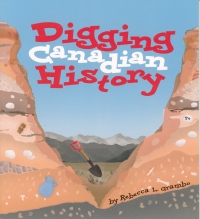| ________________
CM . . .
. Volume XII Number 20 . . . .June 9, 2006 
 |
Digging Canadian History.
Rebecca L. Grambo.
North Vancouver, BC: Walrus Books/Whitecap Books, 2006.
64 pp., pbk., $16.95.
ISBN 1-55285-757-3.
Subject Headings:
Canada-Antiquities-Juvenile literature.
Anthropology-Canada-Juvenile literature.
Natural history-Canada-Juvenile literature.
Canada-History-Juvenile literature.
Grades 3-7 / Ages 8-12.
Review by Val Ken Lem.
*** /4 |
| |
|

excerpt:
The Maritime Archaic people, like those at Port au Choix, lived in Atlantic Canada and Maine from 7,500 to 3,500 years ago. They are called maritime people because they got what they needed to live from the sea. They are known as archaic (ar-KAY-ik), which means “from an earlier time,” because they were hunters and gatherers rather than farmers. Hunting and gathering is the older of the two lifestyles.
The playful title and cover illustration allude to the particular slant of this exploration of Canadian history: archaeological excavations and what they reveal about the past. Grambo, an award-winning writer on natural history, begins with concise explanations of anthropology, archaeology, archaeological methods, historical records and the potential for historic sites to bring history to life.
Most of the book is devoted to introducing the reader to 21 historic sites distributed from coast (L’Anse aux Meadows, NL) to coast (Herschel Island, Yukon) to coast (Skung Gwaii, BC). Every province and territory is represented, but Newfoundland and Labrador with four sites has the greatest coverage. The entries average two pages in length. Grambo recalls events that happened at the sites and describes how artifacts found there help us to understand people and activities from the past. Modern and archival photographs and illustrations provide a good blend of historic images and current restorations along with scenes of archaeologists at work.
Pronunciation guides are included in the text. Side captions on postage stamp shaped backgrounds are entitled “Dig This!” and provide interesting snippets of unique information. Other features are a two-page map of Canada showing all of the sites plus provincial/territorial/national capitals, an index, and a good webliography that includes one website for most of the sites, as well as four major museum and park sites in Canada.
There are a few notable errors that will hopefully be corrected before this work is reprinted. The map transposes the two sites in southern Ontario: The Draper Site, and the Elgin Settlement-Buxton Historic Site. Leif Eriksson and the Vikings are described as having visited North America a half century, rather than a half millennium, prior to Christopher Columbus. A native copper lance point is described as originating near Hull, Quebec, that is now named Gatineau. Finally, the url listed in the webliography for the Uniacke Estate in Nova Scotia now requires an additional element at the end of the address: /archaeo1.htm.
Not all students will find this book interesting, but for those who are inclined, this work can lead to many happy hours of further inquiry.
Recommended.
Val Ken Lem is a catalogue librarian and collection liaison for English, history and Caribbean studies at Ryerson University.

To comment
on this title or this review, send mail to cm@umanitoba.ca.
Copyright © the Manitoba Library Association. Reproduction for personal
use is permitted only if this copyright notice is maintained. Any
other reproduction is prohibited without permission.
NEXT REVIEW |
TABLE OF CONTENTS FOR THIS ISSUE
- June 9, 2006.
AUTHORS |
TITLES |
MEDIA REVIEWS |
PROFILES |
BACK ISSUES |
SEARCH |
CMARCHIVE |
HOME |
